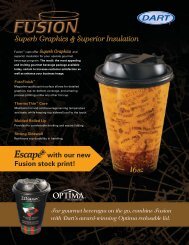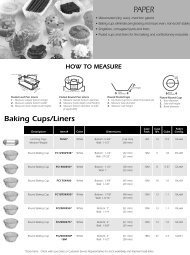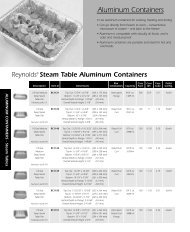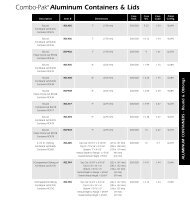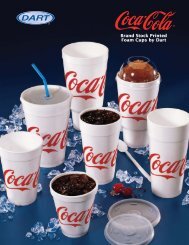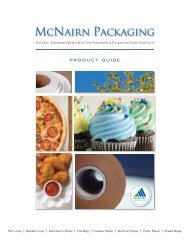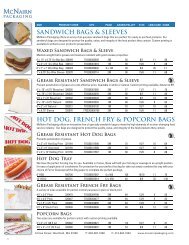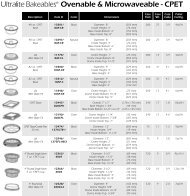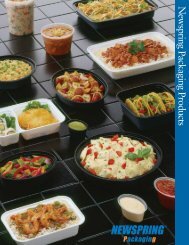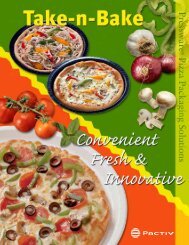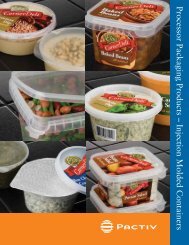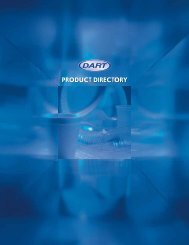Environmental Facts About Polystyrene Foam - Joshen
Environmental Facts About Polystyrene Foam - Joshen
Environmental Facts About Polystyrene Foam - Joshen
- No tags were found...
You also want an ePaper? Increase the reach of your titles
YUMPU automatically turns print PDFs into web optimized ePapers that Google loves.
Take another look …<strong>Environmental</strong> <strong>Facts</strong> <strong>About</strong> <strong>Polystyrene</strong> <strong>Foam</strong>A Life Cycle Inventory Study¹ of polystyrene foamplates and poly-coated paper plates shows that thefoam products have a favorable environmentalimpact compared to the paper products.<strong>Polystyrene</strong> foam bans force restaurants to usealternatives that often have a higher environmentalburden.There is no evidence that polystyrene foambans reduce litter. A recent study of results froma ban on polystyrene foam in Portland, Oregon,shows that the ban has not been successful andshould be repealed. 2The environmental impact of alternatives needsto be studied and carefully considered.Litter is litter. Banning polystyrene foam onlyreplaces one material with another. Recycling andreducing all forms of waste are the best solution tolitter.<strong>Polystyrene</strong> foam is recyclable and, thus, has afavorable environmental impact.Life Cycle Inventory Comparison of 9”<strong>Polystyrene</strong> <strong>Foam</strong> and Poly-Coated Paper PlatesEnergy Usage Greenhouse Gas Potential Material Usage Solid Waste<strong>Polystyrene</strong><strong>Foam</strong>50%Less50%Less2.5 XLess65%Less<strong>Facts</strong><strong>Polystyrene</strong> foam usessignificantly less energy duringits life cycle.Greenhouse Gas (GHG)emissions are significantly lesswith polystyrene foam.<strong>Polystyrene</strong> foam plates are90% air and use 2.5 timesless material.The solid waste impact ofpolystyrene foam issignificantly less.ComparisonBy replacing polystyrene foamReplacing polystyrene foamwith paper alternatives in Losplates with poly-coated paperAngeles County, GHGplates in Los Angeles Countyemissions will increase by anwill increase the energy usageamount equivalent to addingby the equivalent BTU’s of500,000 gallons of gasoline. 1,630 mid-size cars onto3polystyrene foam plates isequal to the weight of 40paper plates. 1California roads each year. 4 The material in 100<strong>Polystyrene</strong> foamfoodservice packagingaccounts for less than 1%by weight and volume ofland-filled materials.¹Final Peer-Reviewed Report: Life Cycle Inventory (LCI) of <strong>Foam</strong> and Coated Paperboard Plates, Franklin Associates, Ltd., May 2008. LCI Study compares 4.7g polystyrene foam plates and 12.1g polycoatedpaper plates. Report available on www.pactiv.com2 Sustainable Failure: Why Portland’s <strong>Polystyrene</strong> <strong>Foam</strong> Ban Should Be Repealed, Cascade Policy Institute, November 2007, www.cascadepolicy.org3 Based on replacing 221,000,000 foam plates with paper plates in LA County and using a value of 125,000 BTU for the energy content of a US gallon of gasoline as per USEPA’s report Solid WasteManagement and Greenhouse Gases – A life Cycle Assesment of Emissions and sinks, 3 rd edition, September 2006, p. 100 (not part of Franklin Assoc. Report referenced in footnote 1),www.eia.doe.gov/basics/conversion_basics.html4 Based on 680 lb CO2 emission increase per 10,000 paper plates, replacing 221,000,000 foam plates with paper plates, and on 9200 lb CO2 emission from an average car as per USEPA’s report Solid WasteManagement and Greenhouse Gases – A life Cycle Assesment of Emissions and sinks, 3 rd edition, September 2006, p. 100 (not part of Franklin Assoc. Report referenced in footnote 1),www.terrapass.com/carbon-footprint-calculator
<strong>Polystyrene</strong> <strong>Foam</strong> – What is it?In addition to <strong>Polystyrene</strong> <strong>Foam</strong>’s environmental benefit, it is:functional and versatile;economical;sanitary, sturdy and safe (FDA Accepted);environmentally friendly as well as resource efficient.A Comparison of Alternative Products vs. <strong>Polystyrene</strong> <strong>Foam</strong>AluminumCosts 2.0 times*more;weighs 1.6 timesmoreMolded Fiber**Costs 3.0 times*more;weighs 2.5 timesmoreStarchCosts 3.0 times*more;weighs 2.6 timesmorePPCosts 2.5 times*more;weighs 3.4 timesmorePLACosts 3.0 times*more;weighs 2.4 times morePaperCosts 3.0 times*more;weighs 2.5 timesmore* Estimated Cost Differences** 100% Virgin Fiber<strong>Polystyrene</strong> <strong>Foam</strong> Packaging is the Best Value.This publication was printed using recycled paper. Provided by Pactiv Corporation, August 2008



